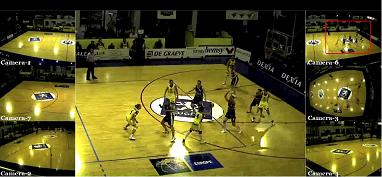
Researchers at the Universite Catholique de Louvain (UCL) in Belgium have successfully developed software that can track basketball players and the ball as they race around the court. The project, Autonomous Production of Images Based on Distributed and Intelligent Sensing (APIDIS), can select between the video feed of several different cameras to find the most interesting footage at a given time. The software can even be told to show preference for a particular player, the star of the team perhaps, and choose the shots which include that player in the frame. It’s also been tested on football (soccer) matches with similar success. APIDIS may be used to reduce the need for human TV staff, making it cheaper to produce video coverage of games with a small audience (i.e. High School, small colleges). We have a video from New Scientist below, as well as some raw data footage, to demonstrate APIDIS in action. This technology could have major sports networks letting computers call the shots, and it heralds some important changes in journalism, surveillance, warfare, and the way we record our lives.
It seems like automation is really focused on journalism. We’ve already seen software that can write a decent baseball story. Statsheet, a sports statistics website, is planning on developing it’s own writer this summer. There’s a robot in Japan that will investigate, interview, and photograph until it finds a story worth publishing on the internet. Now, with APIDIS, computers are taking over the roll of directors and editors, finding the best shots and blending them together to form the visual narrative. How long before automation has come to synthesize every step of the reporting process? In the future, machine-run journalism may allow for a far-broader and cheaper style of reporting, allowing the creation of micro-news feeds tailored to audiences of a few hundred or less. Maybe even an audience of one. Our automated journalists could write stories, and create news footage personalized for each of us. Humans can’t compete with that kind of specificity. It looks like the robots’ first step towards global domination is control of the press.
Footage from APIDIS showing how a single player can be tracked across the court.
More videos of APIDIS footage of basketball and football matches can be found here, and the raw datasets can be found here.
APIDIS also has implications in surveillance and other forms of video monitoring. Software like Vitamin D Video (already on sale) allows for a user to have hours of surveillance footage reduced to a few key highlights for inspection. Now, we have the means to take that automation/evaluation process one step further. A human could never watch the live feeds from a 100 CCTV cameras at once and try to monitor them all for criminal activity. If APIDIS was adapted to that end, it likely could. Together, Vitamin D and APIDIS could take flawed and partially ineffective camera security systems and turn them into effective tools for reporting crime as it happens. As such real time surveillance becomes effective, it may also become preventative.
We also have to remember that military actions are becoming increasingly mechanized. Surveillance drones in the US Armed Forces provide soldiers with a nearly endless stream of video footage. As software continues to advance, it will reduce that footage to highlights that will inform and direct commanders in the field. If programs like Vitamin D and APIDIS become sophisticated enough they could increase the already incredible advantage that unmanned vehicles give to modern armies.
If those seem like heavy consequences for software meant to improve sports coverage, I should mention that UCL has always had higher goals for APIDIS. Sports journalism is one application, so is harnessing the video from mobile devices. APIDIS is part of the ICDSC Challenge, which seeks innovative uses of mobile camera feeds. Could we see APIDIS as a tool to take the thousands of camera phone videos at a concert to provide one movie of the event? The same could be done for protests, disasters, or your child’s birthday party. Sometime in the future it may be possible to run an application on your smart phone letting your video feed be combined with thousands or millions of others as a sort of video social networking. Journalism, surveillance, family movies all using the same kind of technology. Once computers behind the cameras are made smarter, almost anything is possible.
[screen capture credit: APIDIS]
[source: UCL, APIDIS, Paper Published for WIAMIS]


